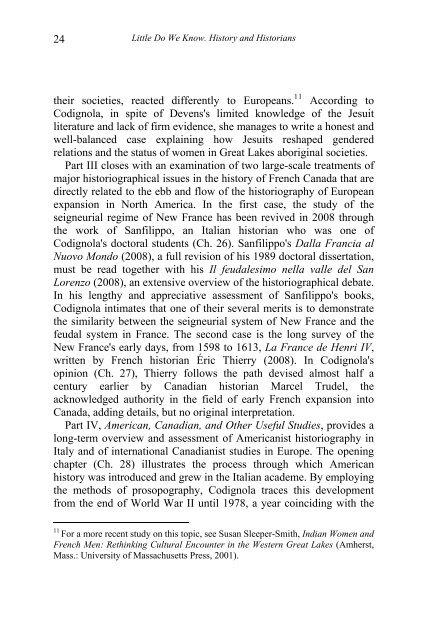Untitled - Istituto di Storia dell'Europa Mediterranea - Cnr
Untitled - Istituto di Storia dell'Europa Mediterranea - Cnr
Untitled - Istituto di Storia dell'Europa Mediterranea - Cnr
Create successful ePaper yourself
Turn your PDF publications into a flip-book with our unique Google optimized e-Paper software.
24<br />
Little Do We Know. History and Historians<br />
their societies, reacted <strong>di</strong>fferently to Europeans. 11 Accor<strong>di</strong>ng to<br />
Co<strong>di</strong>gnola, in spite of Devens's limited knowledge of the Jesuit<br />
literature and lack of firm evidence, she manages to write a honest and<br />
well-balanced case explaining how Jesuits reshaped gendered<br />
relations and the status of women in Great Lakes aboriginal societies.<br />
Part III closes with an examination of two large-scale treatments of<br />
major historiographical issues in the history of French Canada that are<br />
<strong>di</strong>rectly related to the ebb and flow of the historiography of European<br />
expansion in North America. In the first case, the study of the<br />
seigneurial regime of New France has been revived in 2008 through<br />
the work of Sanfilippo, an Italian historian who was one of<br />
Co<strong>di</strong>gnola's doctoral students (Ch. 26). Sanfilippo's Dalla Francia al<br />
Nuovo Mondo (2008), a full revision of his 1989 doctoral <strong>di</strong>ssertation,<br />
must be read together with his Il feudalesimo nella valle del San<br />
Lorenzo (2008), an extensive overview of the historiographical debate.<br />
In his lengthy and appreciative assessment of Sanfilippo's books,<br />
Co<strong>di</strong>gnola intimates that one of their several merits is to demonstrate<br />
the similarity between the seigneurial system of New France and the<br />
feudal system in France. The second case is the long survey of the<br />
New France's early days, from 1598 to 1613, La France de Henri IV,<br />
written by French historian Éric Thierry (2008). In Co<strong>di</strong>gnola's<br />
opinion (Ch. 27), Thierry follows the path devised almost half a<br />
century earlier by Cana<strong>di</strong>an historian Marcel Trudel, the<br />
acknowledged authority in the field of early French expansion into<br />
Canada, ad<strong>di</strong>ng details, but no original interpretation.<br />
Part IV, American, Cana<strong>di</strong>an, and Other Useful Stu<strong>di</strong>es, provides a<br />
long-term overview and assessment of Americanist historiography in<br />
Italy and of international Cana<strong>di</strong>anist stu<strong>di</strong>es in Europe. The opening<br />
chapter (Ch. 28) illustrates the process through which American<br />
history was introduced and grew in the Italian academe. By employing<br />
the methods of prosopography, Co<strong>di</strong>gnola traces this development<br />
from the end of World War II until 1978, a year coinci<strong>di</strong>ng with the<br />
11 For a more recent study on this topic, see Susan Sleeper-Smith, In<strong>di</strong>an Women and<br />
French Men: Rethinking Cultural Encounter in the Western Great Lakes (Amherst,<br />
Mass.: University of Massachusetts Press, 2001).


